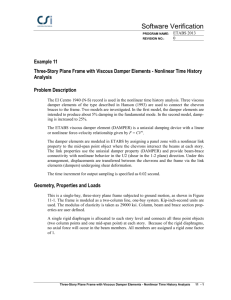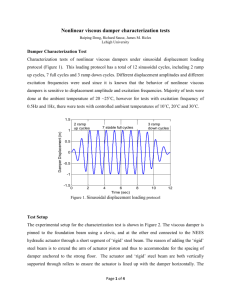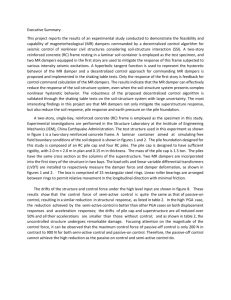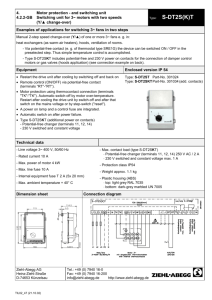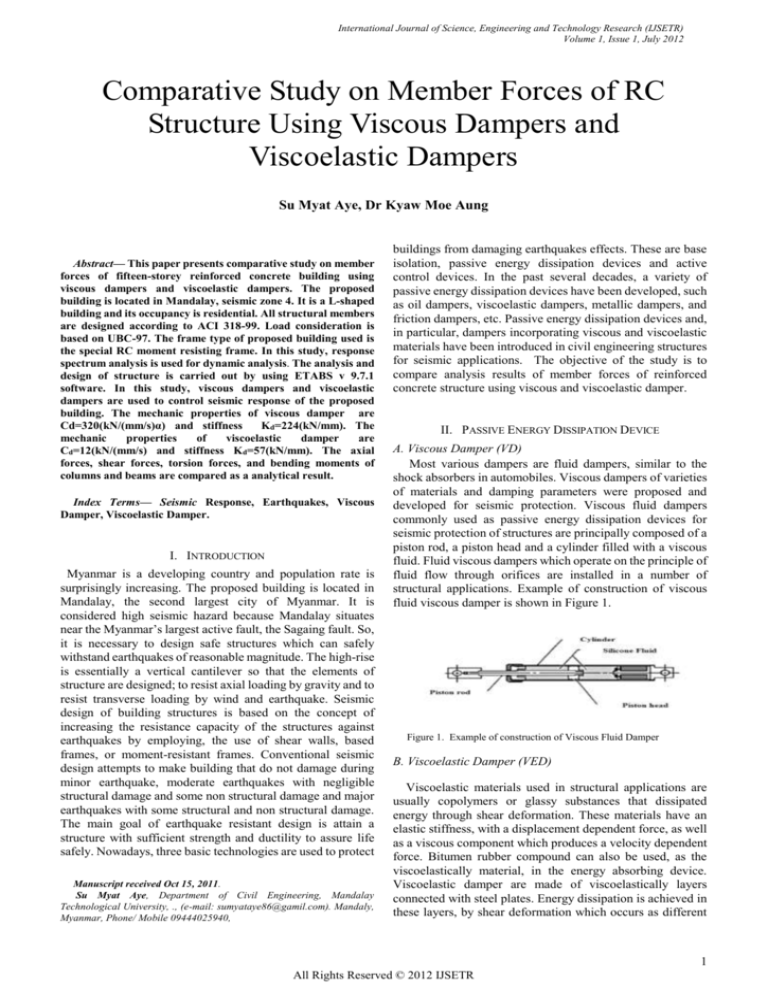
International Journal of Science, Engineering and Technology Research (IJSETR)
Volume 1, Issue 1, July 2012
Comparative Study on Member Forces of RC
Structure Using Viscous Dampers and
Viscoelastic Dampers
Su Myat Aye, Dr Kyaw Moe Aung
Abstract— This paper presents comparative study on member
forces of fifteen-storey reinforced concrete building using
viscous dampers and viscoelastic dampers. The proposed
building is located in Mandalay, seismic zone 4. It is a L-shaped
building and its occupancy is residential. All structural members
are designed according to ACI 318-99. Load consideration is
based on UBC-97. The frame type of proposed building used is
the special RC moment resisting frame. In this study, response
spectrum analysis is used for dynamic analysis. The analysis and
design of structure is carried out by using ETABS v 9.7.1
software. In this study, viscous dampers and viscoelastic
dampers are used to control seismic response of the proposed
building. The mechanic properties of viscous damper are
Cd=320(kN/(mm/s)α) and stiffness
Kd=224(kN/mm). The
mechanic
properties
of
viscoelastic
damper
are
Cd=12(kN/(mm/s) and stiffness Kd=57(kN/mm). The axial
forces, shear forces, torsion forces, and bending moments of
columns and beams are compared as a analytical result.
Index Terms— Seismic Response, Earthquakes, Viscous
Damper, Viscoelastic Damper.
I. INTRODUCTION
Myanmar is a developing country and population rate is
surprisingly increasing. The proposed building is located in
Mandalay, the second largest city of Myanmar. It is
considered high seismic hazard because Mandalay situates
near the Myanmar’s largest active fault, the Sagaing fault. So,
it is necessary to design safe structures which can safely
withstand earthquakes of reasonable magnitude. The high-rise
is essentially a vertical cantilever so that the elements of
structure are designed; to resist axial loading by gravity and to
resist transverse loading by wind and earthquake. Seismic
design of building structures is based on the concept of
increasing the resistance capacity of the structures against
earthquakes by employing, the use of shear walls, based
frames, or moment-resistant frames. Conventional seismic
design attempts to make building that do not damage during
minor earthquake, moderate earthquakes with negligible
structural damage and some non structural damage and major
earthquakes with some structural and non structural damage.
The main goal of earthquake resistant design is attain a
structure with sufficient strength and ductility to assure life
safely. Nowadays, three basic technologies are used to protect
Manuscript received Oct 15, 2011.
Su Myat Aye, Department of Civil Engineering, Mandalay
Technological University, ., (e-mail: sumyataye86@gamil.com). Mandaly,
Myanmar, Phone/ Mobile 09444025940,
buildings from damaging earthquakes effects. These are base
isolation, passive energy dissipation devices and active
control devices. In the past several decades, a variety of
passive energy dissipation devices have been developed, such
as oil dampers, viscoelastic dampers, metallic dampers, and
friction dampers, etc. Passive energy dissipation devices and,
in particular, dampers incorporating viscous and viscoelastic
materials have been introduced in civil engineering structures
for seismic applications. The objective of the study is to
compare analysis results of member forces of reinforced
concrete structure using viscous and viscoelastic damper.
II. PASSIVE ENERGY DISSIPATION DEVICE
A. Viscous Damper (VD)
Most various dampers are fluid dampers, similar to the
shock absorbers in automobiles. Viscous dampers of varieties
of materials and damping parameters were proposed and
developed for seismic protection. Viscous fluid dampers
commonly used as passive energy dissipation devices for
seismic protection of structures are principally composed of a
piston rod, a piston head and a cylinder filled with a viscous
fluid. Fluid viscous dampers which operate on the principle of
fluid flow through orifices are installed in a number of
structural applications. Example of construction of viscous
fluid viscous damper is shown in Figure 1.
Figure 1. Example of construction of Viscous Fluid Damper
B. Viscoelastic Damper (VED)
Viscoelastic materials used in structural applications are
usually copolymers or glassy substances that dissipated
energy through shear deformation. These materials have an
elastic stiffness, with a displacement dependent force, as well
as a viscous component which produces a velocity dependent
force. Bitumen rubber compound can also be used, as the
viscoelastically material, in the energy absorbing device.
Viscoelastic damper are made of viscoelastically layers
connected with steel plates. Energy dissipation is achieved in
these layers, by shear deformation which occurs as different
1
All Rights Reserved © 2012 IJSETR
International Journal of Science, Engineering and Technology Research (IJSETR)
Volume 1, Issue 1, July 2012
components move relatively to each other. Example of
construction of viscous fluid damper is shown in Figure 2.
Figure 2. Example of construction of Viscoelastic Damper
III. MODEL PREPARATION
A. Data for Proposed Structure
The structure is fifteen-storeyed, L-shaped reinforced
concrete residential building. The structure has two normal
stairs and two elevators.
Type of structure
= Fifteen-storey R.C building
Type of occupancy = Residential, two units in each floor
Length of structure = 120ft
Width of structure = 92ft
Ground floor height = 12ft
Typical story height = 10ft
Stair roof height
= 7ft
Overall height
= 169ft
Line plan, and three dimensional view of proposed
damped structure are shown in Figure 3 and Figure 4
respectively.
Figure 3. Line Plan of Proposed Structure
Material properties of the existing building are as shown in
following.
Weight per unit volume of concrete
=150pcf
Specified concrete compressive strength, ƒc ’ =3ksi
Bending reinforcement; yield stress, ƒy
=50ksi
Bending reinforcement; yield stress, ƒs
=50ksi
Modulus of Elasticity, Ec
= 3122ksi
Poisson’s ratio, µ
=0.2
C. Loading Consideration
The applied loads considered in this structural analysis
such as dead loads, live loads, earthquake load and wind loads
are based on UBC-97.
D. Load Combinations
Design codes applied are ACI 318-99 and UBC-97.There
are fourteen number of load combinations which are used in
the structural dynamic analysis.
1. 1.4 DL
2. 1.4 DL + 1.7 LL
3. 1.05 DL + 1.275 LL + 1.275 WX
4. 1.05 DL + 1.275 LL -1.275 WX
5. 1.05 DL + 1.275 LL + 1.275 WY
6. 1.05 DL + 1.275 LL- 1.275 WY
7. 0.9 DL + 1.3 WX
8. 0.9 DL- 1.3 WX
9. 0.9 DL + 1.3 WY
10. 0.9 DL -1.3 WY
11. 0.614 DL + 1.43 SPECX
12. 0.614 DL + 1.43 SPECY
13. 1.3305 DL + 1.275 LL + 1.4025 SPECX
14. 1.3305 DL + 1.275 LL + 1.4025 SPECY
E. Damper Parameters
Damper elements are assigned in ETABS by assigning a
panel zone with a nonlinear link property to the mid-span
point object where the chevrons intersect the beams. The link
properties use the uniaxial damper property (Damper), and
provide beam-brace connectivity with nonlinear behavior in
X direction for damper. Selection of mechanical properties of
viscous and viscoelastic damper including damping
coefficient and stiffness are considered from manufacture’s
test report. Mechanical properties of viscous and viscoelastic
damper are the damping coefficient Cd=320(kN/(mm/s)α)
,stiffness Kd=224(kN/mm) and Cd=12(kN/(mm/s), stiffness
Kd=57(kN/mm). Both viscous and viscoelastic dampers are
installed only in X direction at the base storey of proposed
structure.
IV. STRUCTURAL ELEMENTS FOR PROPOSED STRUCTURE
Figure 4. 3D View of Proposed Damped Structure
B. Material Properties of the Structure
Beam sizes and column sizes of the proposed reinforced
concrete building structure with undamped case, damped case
with viscous and with viscoelastic dampers are described in
this study. Beam sizes are 10″x12″, 10″x14″, 10″x16″,
12″x14″, 12″x16″, 12″x18″, 14″x18″, 14″x20″, 14″x22″,
14″x24″, 16″x18″, 16″x20″, 16″x22″, 16″x24″, 18″x18″,
18″x20″, 18″x22″, 18″x24″, 20″x22″, 20″x24″, and 22″x24″.
Column sizes are 20″x20″, 22″x22″, 24″x24″, 26″x26″,
28″x28″ and 30″x30″. Slab thickness is 5″ for all slabs and
waist thickness is 7″.
2
All Rights Reserved © 2012 IJSETR
International Journal of Science, Engineering and Technology Research (IJSETR)
Volume 1, Issue 1, July 2012
V. COMPARISON OF DYNAMIC ANALYSIS RESULTS
Analysis results of member forces for two cases of
proposed damped structure are compared in this paper.
Comparison of axial force, shear force, torsion force and
bending moment, is described under controlled load
combination 13(1.3305 DL + 1.275 LL + 1.4025 SPECX).
The location of selected columns and beams is shown in the
Figure 5.
Figure 8. Comparison of Torsion of Exterior Column (C24)
From Figure 8, it can be seen that the building with viscous
damper reduce from 12% to 40% of torsion force than that of
building with viscoelastic damper except storey 1 (65%).
Figure 5. Location of Selected Columns and Beams
Comparison of axial force, shear force, torsion force and
bending moment of exterior column C24 under controlled
load combination 13 are shown in Figure 6, Figure 7, Figure 8
and Figure 9 respectively.
Figure 9. Comparison of Bending Moment of Exterior Column (C24)
From this Figure, it can be seen that bending moment of
exterior column for structure with viscous damper is about
32% less than that of structure with viscoelastic damper at
storey 3.
Comparison of axial force, shear force, torsion force and
bending moment of corner column C13 under controlled load
combination 13 are shown in Figure 10, Figure 11, Figure 12
and Figure 13 respectively.
Figure 6. Comparison of Axial Force of Exterior Column (C24)
From this figure, it can be seen that axial force of exterior
column of structure with viscous damper is 9% less than that
of viscoelastic damper.
Figure 10. Comparison of Axial Force of Corner Column (C13)
From this graph, it can be seen that axial force of corner
column of structure with viscous damper is 6% less than that
of structure with viscoelastic damper.
Figure 7. Comparison of Shear Force of Exterior Column (C24)
From the Figure, it can be concluded that shear forces of
exterior column of structure with viscous damper is 25% less
than that of structure with viscous damper.
Figure 11. Comparison of Shear Force of Corner Column (C13)
3
All Rights Reserved © 2012 IJSETR
International Journal of Science, Engineering and Technology Research (IJSETR)
Volume 1, Issue 1, July 2012
From the Figure, it can be concluded that the maximum
reduced percentage of shear force for corner column of
viscous damped structure is approximately 20%.
Figure 15. Comparison of Shear Force of B30
Figure 12. Comparison of Torsion of Corner Column (C13)
From this Figure, it can be concluded that torsion force of
corner column of structure with viscous damper is about 26%
less than that of structure with viscoelastic damper.
Figure 13. Comparison of Bending Moment of Corner Column (C13)
From this Figure, it can be seen that bending moment of
corner column of structure with viscous damper is about 15%
less than that of structure with viscoelastic damper.
From this Figure, shear force of B30 for proposed structure
with viscoelastic damper is 1.2 times greater than that of
structure with viscous damper.
Figure 16. Comparison of Torsion of B30
From this Figure, torsion force of B30 of proposed
structure with viscoelastic damper 1.2 times greater than that
of structure with viscous damper.
Comparison of axial force, shear force, torsion force and
bending moment of selected beam B30 paralleled to
X-direction under controlled load combination 13 are shown
in Figure 14, Figure 15, Figure 16 and Figure 17 respectively.
Figure 17. Comparison of Bending Moment of B30
Figure 14. Comparison of Axial Force of B30
From this Figure, it can be seen that torsion force of B58 of
proposed structure with viscoelastic damper 1.3 times greater
than that of structure with viscous damper at storey 1
From this Figure, bending moment of B30 of proposed
structure with viscoelastic damper is 1.24 times greater than
that of structure with viscous damper.
Comparison of axial force, shear force, torsion force and
bending moment of selected beam B58 paralleled to
Y-direction under controlled load combination 13 are shown
in Figure 18, Figure 19 Figure 20 and Figure 21 respectively.
4
All Rights Reserved © 2012 IJSETR
International Journal of Science, Engineering and Technology Research (IJSETR)
Volume 1, Issue 1, July 2012
Figure 18. Comparison of Axial Force of B58
From this Figure, axial force of B58 of proposed structure
with viscoelastic damper is 1.2 times greater than that of
structure with viscous damper.
VI. DISCUSSION AND CONCLUSION
In this study, viscous and viscoelastic damper are used to
reduce seismic response of the structure subjected to the
earthquake loads. The dimensions of the proposed
fifteen-storey RC building are 120 ft long, 92 ft wide and the
overall height is 169 ft. The proposed building is located in
seismic zone 4. The material properties are concrete
compressive strength, ƒc’= 3000 psi and ƒy= 50000 psi. For
the dynamic analysis, the response spectrum analysis method
is used. Viscous and viscoelastic damper are installed only X
direction at the base storey of the structure.
In the comparison of analysis results of member forces
between viscous damper and viscoelastic damper, it is
founded that the axial forces, shear forces, torsion forces and
bending moment of viscous damped structure are lower than
those of viscoelastic damped structure.
It has been observed that the proposed structure with
viscous damper can reduce column forces and beam forces
more than that of proposed structure with viscoelastically
damper. Therefore, it can be seen that adding viscous dampers
to the structure has better control in reducing member forces.
It can be concluded that seismic response can be reduced by
adding dampers in the structures.
Figure 19. Comparison of Shear Force of B58
ACKNOWLEDGEMENT
From this Figure, it can be found that shear force of B58 of
proposed structure with viscoelastic damper is about 1.2 times
greater than that of structure with viscous damper.
The author is very thankful to Dr. Myint Thein, Rector,
Mandalay Technological University (MTU), for his
invaluable permission and his kind support in carrying out this
paper.
The author would like to express special thanks to her
supervisor Dr. Kyaw Moe Aung, Associate Professor and
Head of Department of Civil Engineering, (MTU) for his very
detailed checks, grateful encouragement, continued patience
and true-line guidance.
The author specially thanks to all her teachers, her family
and her friends for their supports and encouragements.
REFERENCES
Figure 20. Comparison of Torsion of Beam (B58)
[1]
From this Figure, it can be seen that torsion force of B58 of
proposed structure with viscoelastic damper is 1.7 times
greater than that of structure with viscous damper at storey 1.
[2]
[3]
[4]
[5]
[6]
[7]
[8]
Figure 21. Comparison of Bending Moment of B58
From this Figure, it can be seen that bending moment of
B58 of proposed structure with viscoelastic damper is 1.07
times greater than that of structure with viscous damper.
[9]
Arthur H. Nilson: Design of Concrete Structure Twelfth Edition,
McGraw-Hill, Inc.(1997)..Arthur H. Nilson: Design of Concrete
Structure Twelfth Edition, McGraw-Hill, Inc.(1997)..
(1997), Uniform Building Code, Volume 2, U.S.A, Structural
Engineering Design Provisions, International Conference of Building
Officials.
American Concrete Institute 1999: Building Code Requirement for
Structural Concrete (318-99). U.S.A
ETABS Version 9.6 “Computers and Structures”, Inc; Berkeley;
California.
Hanson, R.D.1993. Supplemental Damping for Improved Seismic
Performance. Earthquake Spectra, Vol.9, Number3, (319-334).
Lee D, Taylor DP. Viscous damper development and future trends.
Strut Des Tall Build 2002; 10(5):311-20.
Fu, Y. and Kasai, K. (1998). Comparative study of frames using
viscoelastic and viscous damper Journal of Structural Engineering.
124:5. 513- 522.
JSSI Manual, Chinese Translation.(2008). Design And Construction
Manual for Passively Controlled Buildings, Japan Society of Seismic
Isolation (JSSI), China Architecture & Building Press, Beijing, China
(in Chinese).
In-Structure Damping And Energy Dissipation (Revision 0; July,2001)
, Trevor E Kelly, S.E., Holmes Consulting Group.
5
All Rights Reserved © 2012 IJSETR
International Journal of Science, Engineering and Technology Research (IJSETR)
Volume 1, Issue 1, July 2012
6
All Rights Reserved © 2012 IJSETR



